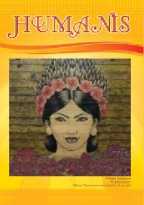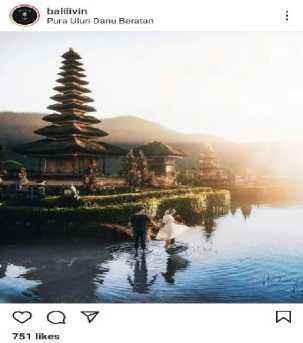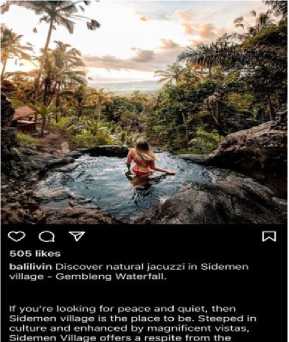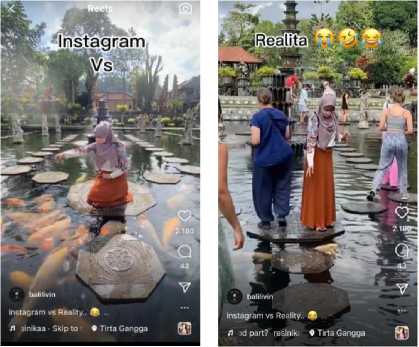Bali Tourism Discursive Strategies in “Balilivin” Instagram Account
on

p-ISSN: 2528-5076, e-ISSN: 2302-920X
Terakreditasi Sinta-3, SK No: 105/E/KPT/2022
Vol 26.4. Nopember 2022: 369-376
Ni Wayan Ita Pratistita, Putu Nur Ayomi*, Putu Devi Maharani, Ida Ayu Mela Tustiawati
Universitas Mahasaraswati Denpasar, Bali, Indonesia
Correspondence Email: itapratistita@gmail.com, putu.nur.a@unmas.ac.id, devi.maharani@unmas.ac.id, mela.tustiawati@unmas.ac.id
Info Artikel
Submitted: 16th October 2022
Revised: 30th October 2022
Accepted: 4th November 2022
Publish: 30th November 2022
Keywords:
tourism; instagram; social media; discursive strategy
Corresponding Author:
Putu Nur Ayomi,
Email:
DOI:
Abstract
Today's popularity of a tourist destination is often supported by its existence on social media. Engaging narratives and pictures influence visitor interest in traveling to an area. This study aims to see the discourse strategy used by a highly followed Instagram account @balilivin in promoting tourist attractions in Bali using the theory of Wodak & Meyer (2001). The data was collected in January 2022. Using descriptive-qualitative method, the study found that most posts divide human social actors into visitors and locals. Bali as a destination and its people is described with a highly positive image with bombastic words. Pictures and captions framed Bali as an ideal paradise apart from various realities unshown on social media.
INTRODUCTION
Tourism is a potential industry to be developed as a source of community income. In six decades, it had become the fastest sector to grow economically (Antara & Sumarniasih, 2017). Due to this expansion, many new tourism destinations continuously emerge in Asia and Africa. In addition, the advancement of transportation and communication technology also boost the tourism industry as they make it easier to travel from one place to another and promote tourist destination.
For Bali, tourism has become the most significant sector that supports the island economy. However, the role of
promotion, primarily through social media and the Internet, cannot be underestimated as Bali must compete with other destinations.
The exponential growth of the Internet and social media in this decade has affected many aspects of life; tourism is one of them. As the most potent networking media, social media plays a vital role as a platform where people can introduce, share, exchange, and discuss about places. According to Zeng & Gerritsen (2014), social media dramatically impacts decision-making, as it is an essential source of information and reviews about tourist places. Furthermore, the Internet enables the
potential tourist to virtually visit a destination and access information regarding the place prior to their physical tours (Hallett & Kaplan-Weinger, 2010). Therefore, countries and those working in tourism in general view social media as a key to promoting destinations.
In Indonesia, one of the social media that is widely used is Instagram. Currently, it has over 800 million monthly active users, 500 million daily active users, and 300 daily stories active users (Instagram, 2018). Instagram is a visually-oriented SNS; images are undoubtedly the most features appearing on the site; the mode of representation available on Instagram includes photography, videos, audio, reels, explore, live, text, etc., with such a variety of features on the site, people use Instagram for various purposes such to express and showcase their aesthetic abilities, and a strategic tool for travel branding.
In social media, the “talk” about tourism destinations is not only produced by the industry or government. Individual users can also provide information about traveling and leisure. Concerning Bali, many accounts post and talk specifically about travel and life on the island, such as Balidaily and Balivin. Those accounts usually post about beautiful tourist spots in Bali, from mountains, beaches, and temples to beach clubs. Occasionally they also post about some exciting happening in Bali.
The posts about Bali on social media usually contain attractive photos and highly persuasive language that captivate people, making them want to travel. Language is eventually a tool to sell. In other words, this highly persuasive language sells a product by describing a reality – the destination – in such a way as to be perceived by the target reader – the tourist – as authentically and interesting. Such persuasive language is constructed in
texts where verbal and iconic elements are interwoven. When the texts are uploaded on the web, their potentialities are amplified (Crystal, 2001: 205) .
There are many studies discussing the verbal and visual aspects of tourism advertisements, this can be seen in posters and videos analysis using semiotic perspectives such as by Pratiwi, Ayomi, & Candra (2017a; 2017b) and their stylistic and figure of speech used (Aprinica, 2021; Budiharjo, et. al., 2022). Isti’anah (2020) has studied the language of attitude and eco-lexicon used in Indonesian tourism websites. Ayomi (2021a, 2021b, 2022) and Kasni & Budiarta (2021) has also studied the language used in social media using the perspective of Critical Discourse Analysis (CDA). However, the research using the perspective of discursive strategies used to promote tourism destinations, especially by social media users, is still understudied, considering its different nature.
This study attempts to comprehensively describe the discursive strategies used in the Instagram post by the Balilivin Instagram account. The account is chosen because although it is relatively new compared to the previous two, it has high number of followers, the highest number of posts and high engagement, seen from the number of comments and likes. The account has about 307.000 followers and has the tagline “ultimate guide to discover Bali and beyond.” By employing the theory of Wodak & Meyer (2001), this study explores how some representations of Bali are built in social media.
METHOD AND THEORY
In this study, the writer used qualitative method (Creswell, 2013). Data was collected during the period of January 2022. As many as twenty-five data were collected from Balilivin Instagram posts. The main concern of
this research is to analyze the captions posted in English.
The theory that are used in this research are based on the Critical Discourse Analysis (CDA) perspectives, specifically focusid on the discursive strategies analysis. The theory of discourse strategy is taken from Wodak & Meyer (2001).
Table 1: Discursive Strategies (Wodak & Meyer, 2001).
|
Strategy |
Objectives |
Devices |
|
Referenti-al/nomina tion |
Construction of in group and out groups |
Membership categorization Biological, naturalizing and depersonalizing metaphors and metonymiesSyn ecdoches |
|
Predication |
Labelling social actors more or less positively or negatively, deprecatori -ly or appreciate-vely |
Stereotypical, evaluative attributions of negative / positive traits Implicit and explicit predicates |
|
Argument ation |
Justification of positive or negative attributions |
Topoi used to justify political inclusion / exclusion, discrimination / preferential treatment |
|
Perspecti vation, framing of discourse representa tion |
Expressing involvement positioning speaker’s point of view |
Reporting, description, narration / quotation of events and utterances |
|
Intensific ation, mitigation |
Modifying the epistemic status of a proposition |
Intensifying or mitigating the illocutionary force of utterances |
This research is aimed at knowing the ideology contained in a caption on the post on Instagram account. The writer chose one Bali travel account on instagram. The Balilivin instagram account is one of the famous website that provides knowledge about interesting things about Bali. This Instagram account offers a wholesome and distinct insight into the wonders of the Indonesian archipelago, especially the island of Bali.
Some steps are done by the writer in this research. Those steps are (1) determining the post to be analysed; (2) collecting all the data; (3) classifying the post on the media used; (4) analysing the discursive strategy of each post.
The theory of discursive strategy is taken from Wodak & Meyer (2001) According to them, there are five strategies that can be used to reveal the power that is used by some people or group. (Table 1)
RESULT AND DISCUSSION
Regarding Balilivin's posts about tourism information in Bali, which are chosen purposively as they present the "typical" post about the tourism spot of Bali by Balilivin account. It is found that Bali is represented exaggeratedly positively. Bali and its areas are referred to as “destinations" and places that possess beauty. The actor is dominantly visitor that can do various activities in Bali. The narrative is convincing and invites travellers to visit Bali.
Referential/Nomination
Referential strategies are approaches to naming individuals or groups of people through which social membership is construed, and nomination strategy serves to construct social actors, objects/ phenomena/ events, and processes/ actions (Wodak, 2015). A participant (social actor) is a person who can do something, usually a human participant. The social actors mentioned in the posts
are, firstly, the elliptic narrator, the anonymous writer of the post, representing the Balilivin Instagram account. The second is visitors or the audience of the posts, sometimes addressed as you by the narrators, as in the sentence if you’re looking for peace and quiet, then Sidemen village is the place to be. In many cases, the narrator talks to the audience directly, inviting, giving suggestions, and welcoming them.
The other social actors are the locals or Balinese people. The account describes what the locals do, e.g. women gracefully balancing piles of fruit offerings on their way to the temple and how the Balinese treat visitors: the artist (bapak) super friendly, he welcome us very warmly to have a good picture with the pots.
Other objects presented in the post mainly relate to places such as beaches, mountains, rice fields, lakes, and temples. They are described by mentioning other objects constituting those places by meronymic relations such as “The spectacular mountainous region around Kintamani with deep Crater Lake and bubbling hot springs, make this region a must to visit” in which Kintamani consist or mountains, crater lake, and hot springs or the relation between beach with waves, sand, sun, or reef.
Objects in nature dominate the posts instead of the narrative about temples and culture. The objects related to cultures presented are ceremonies such as melukat and its properties, Balinese holidays, and temple history.
Aligned with Pesaresi & Abbasian (2022) studies that found most photos posted on the social media about Italy include people, contrary to traditional brochures and magazine that usually only show the place, this study also find that most of the photos include the picture of tourist enjoying the destination as can be seen in figure 1.

Figure 1. A Tourist Couple Posed in front of a Temple
Predication
The predication strategy analyses the traits, characteristics, features, and qualities attributed to the in-groups and out-groups through synecdoche and negative and positive qualities (R. Wodak, 2015). It refers to the intention of speakers to describe social actors negatively and positively. Metaphorical expressions are used in describing people. There is no evidence of discrimination between in-groups and out-groups in any of the posts. However, some posts on Balilivin divide participants become tourists or visitors and local people/Balinese people.
Tourists here are described as people who are full of curiosity, love to learn new things, full of energy, and adventurous. This is shown by the verbs suggested by the narrators, such as discover, sail, learn, escape, surf, etc., and especially by the pictures showing visitors doing various activities. The locals are friendly, humble, kind, helpful, and creative. The predication of Balinese people can be seen in the caption, such as “a Balinese family business that has been making handmade pots for generations, he is super friendly and also sells with the affordable price.”
On the other hand, there are some posts related to places. Beaches, for example, are described as beautiful with
white sand, epitome of paradise, popular surf spots, etc. The mountains are magnetized, magnificent, authentic, precious, and cool. Nature is described as calm, exotic, and relaxing, with lush green trees.
It can be concluded that everything about Bali has positive characteristics, both from its nature, people, tourist attractions, and culture.
Argumentation
Argumentation is a communication process that goes along with any informatively significant language construct and serves as a universal technique to transfer information through the discourse acts. In other words, argumentation is the core message of data. From the data analysed by the writer, it can be concluded that Bali has many good destinations; as described in the caption, Bali is more than a place; it’s a mood, it is magical. It’s a tropical state of mind. Bali is a tourist much seeks a place with a variety of cultures, arts, and beautiful nature. Balinese tradition is explained by the adjective deep-rooted culture that is passed down from generation to generation. On the other hand, Bali is also described as having dynamic culture. It means that the culture interacts and changes because it is in contact with other cultures, which later brings some modernization into its cultural practices, without losing its identity.
Perspectivation
This strategy describes the attempt of a speaker to get his audience involved through various techniques such as describing, reporting, narrating, and quoting sentences. There are many ways the narrator of Balilivin talks to the audience. The first is by simply describing without personal involvement. For example, as a narrator, the writer tells about the beauty of Bali as seen in the
sentence, "Tirta empul is an important temple complex and holy mountain spring, located in the village of manukaya in central Bali…." Here, the narrator tells about one of the tourist destinations in Bali. The language used tends to only inform the place without telling the reader whether or not the narrator ever experienced the place personally, so there is no reciprocity from the readers.
Secondly, the narrator presents herself as someone who really knows the place and personally suggests the Instagram viewer to do something, such as in the example: Another Instagram spot in Ubud!', when you're here in Ubud, don't forget! Stop by at Serayu Pot and Terracota instagram @serayupot is a colourful poetry studio located at Jalan Gunung Sari, 5 minutes from Ubud center". Here the narrator addresses the audience as you. From the caption written by the writer, the narrator wants to invite and gives recommendations to readers to try one of these Instagramable spots in Bali.

Figure 2. Highly Idealized Landscape Post
Besides the captions, social media's most dominant framing device is the picture. As seen in figure 2, the image built about Bali, Sidemen, is a secluded, serene, heavenly, and idealized place.
The photo frame only presents the excellent part, cutting the other reality and surrounding that might be not so paradisal.
Intensification and Mitigation
Intensification is phrases or sentences that increase meanings. In most posts, it can be seen that n Balilivin uses highly positive exaggerating meaning, and sometimes even have excessive meanings such as epitome of paradise, best panoramic, magical, untouched beauty, and exotic. The reader will imagine the atmosphere only through writing. This strategy has a significant impact on the readers.
This, however, is sometimes questionable because the image people see on social media is highly curated. Meaning is fabricated and sometimes different from reality. Bali is a populous modern island facing various ecological and social problems. It is, in many cases, far from being a paradise.
A survey conducted by Hayhurst (2017) suggested that 40% of young travellers choose a destination based on how instagramable the place is. Creating a great photo in this era of social media is a big part of traveling experience (Abdul Razak & Mansor, 2021). As a photo can show only a tiny fraction of reality, pictures can easily choose the best things to be presented with the right angle and perspective while at the same time ignoring the other realities.
Although the strategy of mitigation is rarely used in the post, in some Instagram stories, Balilivin Instagram account also shows videos comparing what is shown on Instagram and what happens in reality. This is done by contrasting some Instagram posts showing some beautiful places and the video of a big crowd of visitors having to queue up for a photo session.

Figure 3. Instagram vs Reality Reels
By giving this information, the narrator can mitigate the overhigh expectation and give precaution to the audience to not always believe what they see on social media.
CONCLUSION
The main objective of this study was to identify the discourse strategies used by Balilivin Instagram account to create a good representation of tourism destinations in Bali. The current tourism information strategy must be considered to increase the tourism business, especially in Bali. As the analysis suggested, all the components of discourse strategies are used to create a highly positive image of places shown by grandeur vocabularies. Bali is depicted as an unchanged heavenly place with deep-rooted traditions and friendly locals. The narrative highlights what visitors as the social actor can enjoy and do in Bali. While focusing more on the object of nature and the countryside, the visual images posted primarily frame Bali’s landscape as tranquil, calm, and peaceful, away from the crowd of mass tourism.
REFERENCES
Abdul Razak, R., & Mansor, N. A.
(2021). Instagram Influencers in Social Media-Induced Tourism (pp. 135–144).
https://doi.org/10.4018/978-1-
7998-7095-1.ch009
Antara, M., & Sumarniasih, M. S. (2017). Role of Tourism in Economy of Bali and Indonesia. Journal of Tourism and Hospitality
Management, 5(2).
https://doi.org/10.15640/jthm.v5n2 a4
Aprinica, N. P. I. (2021). Style of
Language in Tourism Hotel
Advertising. Linguistic, English Education and Art (LEEA) Journal, 5(11–18).
Ayomi, P. N. (2021a). Managing Interpersonal Meaning in Social Media: a Case Study of Indonesian Language Use. Academic Journal Perspective: Education, Language and Literature, 9(1).
Ayomi, P. N. (2021b). Trump Vs Jokowi: Exploring the Lexicogrammatical Variation of Head of States’ Twitter Communication. LITERA, 20(1), 179–195.
https://doi.org/10.21831/ltr.v20i1.3 4554
Ayomi, P. N. (2022). Realisasi Makna Sikap Sebagai Pengungkap Pendirian dalam Percakapan Tentang Vaksinasi Covid-19 Di Twitter. Aksara, 34(1), 121–134.
https://doi.org/10.29255/aksara.v34 i1.814.121-134
Budiharjo, B., Nuraeni, A., Saptaningsih, N., Murti, B. D., & Rusjayanti, A. (2022). Persuasion in Tourism Promotion Bilingual Texts: The Importance of Syntactic Forms and Choices. Leksema: Jurnal Bahasa Dan Sastra, 7(1), 1–12.
https://doi.org/10.22515/ljbs.v7i1.4 419
Creswell, J. W. (2013). Research design: Qualitative, quantitative, and mixed methods approaches (Fourth Edi). Los Angeles: Sage
Publication.
Crystal, D. (2001). Language and the Internet. Cambridge University
Press.
https://doi.org/10.1017/CBO97811 39164771
Hallett, R. W., & Kaplan-Weinger, J. (2010). Official Tourism Websites. Multilingual Matters.
https://doi.org/10.21832/97818454 11381
Hayhurst, L. (2017). Survey highlights Instagram as key factor in
destination choice among
millennials.
Isti’anah, A. (2020). (Re)evaluating language attitudes on Indonesian tourism website: A study on ecolinguistics. Studies in English Language and Education, 7(2),
622–641.
https://doi.org/10.24815/siele.v7i2. 16683
Kasni, N. W., & Budiarta, I. W. (7AD). The multimodal forms of tourism promotional discourse in the age COVID-19. Journal of Linguistics, Literature and Culture, 6, 422-440.
Pesaresi, A., & Abbasian, S. (2022).
Reality and Fiction: Scandinavian Tour Operators’ Image of Italy through Photographs. Journal of Quality Assurance in Hospitality & Tourism, 1–26.
https://doi.org/10.1080/1528008X. 2022.2035296
Pratiwi, D. P. E., Ayomi, P. N., &
Candra, K. D. P. (2017). Balinese Arts and Culture As Tourism Commodity In Bali Tourism Promotion Videos. Mudra Jurnal Seni Budaya, 32(2).
Pratiwi, Desak Putu Eka, Ayomi, P. N., & Candra, K. D. P. (2017). Representation of Bali in Tourism Advertisement Videos.
International Journal of
Linguistics, Literature and Culture, 3(5), 14–25.
Wodak, R. (2015). Critical Discourse Analysis, Discourse‐Historical
Approach. In The International
Encyclopedia of Language and Social Interaction (pp. 1–14). Wiley.
https://doi.org/10.1002/978111861 1463.wbielsi116
Wodak, R. T., & Meyer, M. (2001). Methods of Critical Discourse Analysis. London: Sage
Publication.
Zeng, B., & Gerritsen, R. (2014). What do we know about social media in tourism? A review. Tourism Management Perspectives, 10, 27– 36.
Discussion and feedback